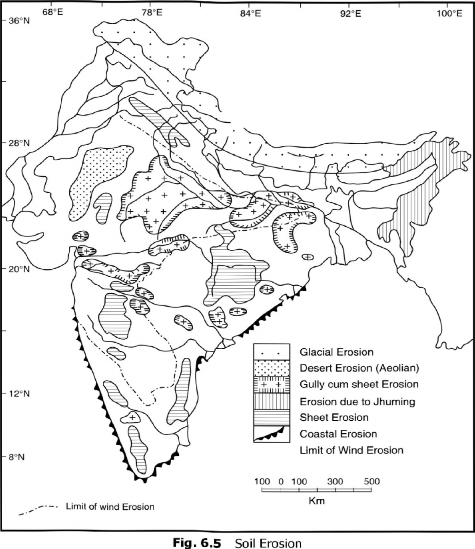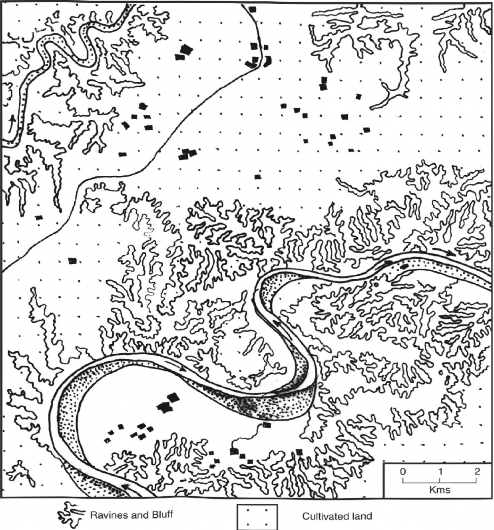(i) Soil Erosion
Soil erosion refers to the removal of top soil. Soil erosion is a growing menace in many parts of India. When the top soil is removed, it is known as sheet erosion, and when the runoff makes gullies, it is known as gully erosion. In India, soil erosion is a universal problem. In the areas where rainfall is heavy water is the main agent of soil erosion, while in the arid and semi-arid areas wind is responsible for soil erosion. According to one estimate about 180 million hectare (about 60 per cent of the total area of the country) is adversely affected by soil erosion.
The main agents of soil erosion are water, wind, sea-waves, glaciers, and shifting cultivation. The areas adversely affected by the different agents of erosion have been shown in (Fig- 6-5). Out

of these, water is the most important agent of erosion. Water erosion may be classified under three categories: (a) surface erosion or the uniform removal of soil from the surface, (b) Rill erosion in which the running water makes finger-shaped grooves in the land, and (c) gully formations, in which the rills are enlarged, making the land bad and unsuitable for cultivation. A typical example of gully erosion is provided in the Chambal valley in Madhya Pradesh. Rajasthan, and I Jttar Pradesh also provide typical examples of gully erosion. (Fig. 6.6). Gully erosion is also significant in the Shiwalik tracts of Punjab, Haryana, Himachal Pradesh, Jammu and Kashmir, Uttarakhand, Uttar Pradesh and along the southern slopes of Himalayas, and the Western and Eastern Ghats.
Wind erosion is significant in the arid and semi-arid areas of Rajasthan, Haryana, Punjab, western Madhya Pradesh and Gujarat. Wind erodes soil along the coastal plains of Peninsular India. Thousands of hectares of fertile lands of Uttar Pradesh, Gujarat, Haryana, Punjab, and western Madhya Pradesh have been adversely affected by this process.
The tidal waters of the Arabian Sea and the Bay of Bengal cause considerable damage to the soils along the coastal areas. Severe erosion of beaches along the Kerala, Tamil Nadu, Andhra Pradesh, Odisha, and Gujarat coasts is the example of sea-wave erosion.

Chambal Ravines
Fig. 6.6 Gully Erosion in Chambal Valley
The largest area affected by soil erosion is in the state of Rajasthan, followed by Madhya Pradesh, Maharashtra, Uttar Pradesh, Gujarat, Andhra Pradesh and Karnataka, The worst affected areas of soil erosion include: (i) Chambal and Yamuna rivers (Fig. 6.6), (ii) the southern slopes of Shiwaliks, Lesser and Greater Himalayas, (iii) the Western and Eastern Ghats, (iv) the Chotanagpur Plateau, and (v) the arid and semi-arid areas of Rajasthan, Gujarat, Haryana, and Punjab.
